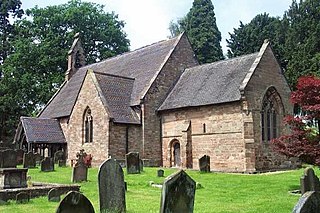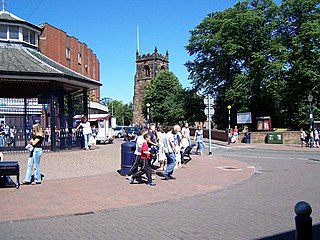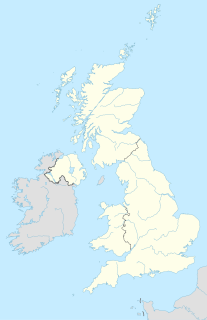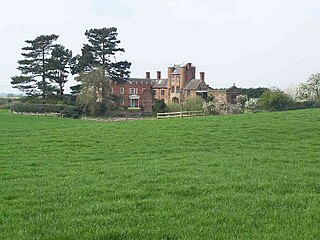
Baron Hatherton, of Hatherton in the County of Stafford, is a title in the Peerage of the United Kingdom. It was created in 1835 for the politician Edward Littleton, Chief Secretary for Ireland from 1833 to 1834. Born Edward Walhouse, he assumed in 1812 by Royal licence the surname of Littleton in lieu of his patronymic on succeeding to the estates of his great-uncle Sir Edward Littleton, 4th and last Baronet, of Teddesley Hall. He was also heir to the substantial Walhouse estates and interests, which included Hatherton Hall, near Cannock, then in an exclave of Wolverhampton. His wealth was based landed estates centred on Penkridge in southern Staffordshire, mines at Great Wyrley and Bloxwich, quarries and sandpits, brick yards and residential housing, mainly in Walsall.

The Staffordshire Way is a long distance walk in Staffordshire, England. The path links with the Cheshire Gritstone Trail, the Heart of England Way and the North Worcestershire Path.

The River Penk is a small river flowing through Staffordshire, England. Its course is mainly within South Staffordshire, and it drains most of the northern part of that district, together with some adjoining areas of Cannock Chase, Stafford, Wolverhampton, and Shropshire. It flows into the River Sow, which is a tributary of the River Trent, so its waters flow ultimately into the North Sea via the Humber Estuary.

Three baronetcies have been created in the Baronetage of England for members of the Littleton or Lyttelton family. All three lines are descended from Thomas de Littleton, a noted 15th-century jurist. Despite differences in spelling of the title, the names of all three lines were spelt in many varied ways in the early modern period, without distinction between the different branches of the family. This can be confusing, as the range of forenames in use was very limited.
The Staffordshire Club Cricket Championship is the main cricket league in South Staffordshire.
Dunston is a small village in England lying on the west side of the A449 trunk road about 3 miles (4.8 km) south of Stafford, close to Junction 13 of the M6 motorway. The population of the village at the 2011 census was 281. It lies at roughly 300 feet above sea level.
Levedale is a small somewhat elongated English village situated some 4 miles southwest of Stafford, 2 miles northwest of Penkridge and a mile west of Dunston, Staffordshire. The population as taken at the 2011 census can be found under Penkridge
South Staffordshire College is a further education college located over four sites in Staffordshire, England.
Teddesley Hall was a large Georgian English country house located close to Penkridge in Staffordshire, now demolished. It was the main seat firstly of the Littleton Baronets and then of the Barons Hatherton. The site today retains considerable traces of the hall, gardens and other buildings, while the former home farm remains a working farm.

Penkridge is a market town and parish in Staffordshire with a history stretching back to the Anglo-Saxon period. A religious as well as a commercial centre, it was originally centred on the Collegiate Church of St. Michael and All Angels, a chapel royal and royal peculiar that maintained its independence until the Reformation. Mentioned in Domesday, Penkridge underwent a period of growth from the 13th century, as the Forest Law was loosened, and evolved into a patchwork of manors of greatly varying size and importance, heavily dependent on agriculture. From the 16th century it was increasingly dominated by a single landed gentry family, the Littletons, who ultimately attained the Peerage of the United Kingdom as the Barons Hatherton, and who helped modernise its agriculture and education system. The Industrial Revolution inaugurated a steady improvement in transport and communications that helped shape the modern town. In the second half of the 20th century, Penkridge grew rapidly, evolving into a mainly residential area, while retaining its commercial centre, its links with the countryside and its fine church.
Sir Edward Littleton of Pillaton Hall, 2nd Baronet, was a Staffordshire landowner and MP from the extended Littleton/Lyttelton family, who represented Staffordshire in the Cavalier Parliament.

Sir Edward Littleton of Pillaton Hall, 4th Baronet, was a long-lived Staffordshire landowner and MP from the extended Littleton/Lyttelton family, who represented Staffordshire in the Parliament of Great Britain and the Parliament of the United Kingdom for a total of 28 years. The last of the Littleton Baronets of Pillaton Hall, he transferred the family seat from eponymous Pillaton to Teddesley Hall, and died childless, leaving the estates to his great-nephew, Edward Walhouse, who became Edward Littleton, 1st Baron Hatherton.

Edward Littleton or Edwarde Lyttelton was a Staffordshire landowner from the extended Littleton/Lyttelton family. He also served as soldier and Member of Parliament for Staffordshire in the House of Commons of England, the lower house of the Parliament of England, five times.

Sir Edward Littleton was a politician from the extended Littleton/Lyttelton family and an important Staffordshire landowner of the Jacobean era and the early Caroline era. Although loyal to the monarchy, he seems to have been of Puritan sympathies and was a close ally of Robert Devereux, 3rd Earl of Essex. He represented Staffordshire in the English parliament of 1624.

St John's Church, Stretton is the Church of England parish church of Stretton, South Staffordshire.

Chadsmoor is an urban settlement within Cannock Chase District in the County of Staffordshire, England and lies between the wards of Cannock and Hednesford in South Staffordshire.
Penkridge is a civil parish in the district of South Staffordshire, Staffordshire, England. It contains 76 listed buildings that are recorded in the National Heritage List for England. Of these, one is listed at Grade I, the highest of the three grades, two are at Grade II*, the middle grade, and the others are at Grade II, the lowest grade. The parish contains the town of Penkridge, smaller settlements including Bickford, Levedale, Pillaton, and Whiston, and the surrounding countryside. Most of the listed buildings are houses and associated structures, cottages, farmhouses, farm buildings, public houses, and shops, the earlier of which are timber framed or have a timber framed core. The other listed buildings include a church, monuments and other structures in the churchyard, bridges, stocks and a bench, a former lock-up, a railway viaduct, a public library, and a mill.














